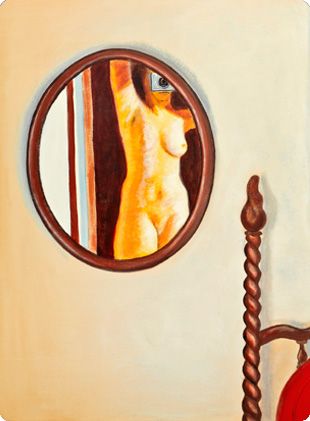
Author: Wanda Richter Forgách
By: Asilo Bianco Cultural Association
Textus receptus by Francesca Gattoni, Asilo Bianco
The figures depicted in Wanda Richter-Forgách’s betray evidence of significant personal experiences most likely too cumbersome to be brushed aside and left without a trace. She portrays tired female faces, sometimes covered in soft white cloths or draped in classic white tunics, their brilliance magnified by the chromatically saturated backgrounds in which the artist highlights the flesh tones. These contemporary “bathers” in their silent reflection have replaced for Renoir’s light, joking artistic conversation. Their reflection estranges them from time, suspends them in a mentally and physically undefined space; there are no chairs or benches, but the bathers appear to be sitting inside a Turkish bath, perhaps the very same bath in which Ingres painted his nudes more than a century ago. Their stately bodies tower above the canvas and the spectator, containing within themselves the power of femininity.
Richter-Forgach continuously calls upon the observer’s memory, including her use of a small white round table trimmed in iron that appears the same as one from 1901, the year in which Pablo Picasso, during his second stay in Paris, created the painting ‘Woman Drinking Absinthe’, exploring the theme of solitude that came about with the isolation of the contagious sick and managed to extend much further than just those directly affected. The woman seated at the small table in an ice cream shop in (title pending) is alone, too consumed in her cell phone conversation to notice what is happening around her. She doesn’t even notice that the person to whom she is speaking is actually watching her from outside the shop, reflected in the glass. A more politically correct version of the Fée Verte (green fairy), a drink very dear to the artists of the nineteenth century decadent movement, the less improper cup of ice cream is substituted in to occupy the center of the painting.
This game of mirrors resurfaces in other artwork, in which the subjects appear on the surface to be inside, but the real focus of the scene turns out to be the women, or rather their absence, that takes shape in the reflected image which is correlated with a symbol. This symbol may be a red fish locked away in a glass prison, enchanting but ever hidden in reclusion, or an intense red lilium, the same lily as that born from a drop of milk that had fallen from Juno’s bosom as she nursed Hercules and which, for Christians, has become the symbol of purity and chastity. In this last case, we see an obvious appeal to the bond that unites the symbology of the flower with that of female sensuality and sexuality.
‘Eve’ is the name that Adam, the first man mentioned in the book of Genesis, gave to his companion, after initially simply calling her ‘woman’: “This is now bone of my bones and flesh of my flesh; she shall be called ‘isshah (woman)’, for she was taken out of ish (man).” The Bible also tells of a virgin stabbed with seven swords, one for each of the seven deadly sins, and a bleeding heart...the Sacred Heart...which communicates with the Madonna and her Son and is depicted by a wooden statue similar to the models created in the region between Verbano and Cusio by the very well-known Milanese sculptor Bartolomeo Tiberino of the Madonna-Mother who captured the imagination of the artist one afternoon in Ameno.
‘Eva (Eve)’ is also the title of two pieces of artwork from the German artist; Eve, literally ‘she who gives life’, falls into the mud and transforms into a warrior, but she is able to lift herself up again with more strength and determination than before. In fact, she rises up with a sort of armor protecting her left arm, her knees, and her right wrist; she has become gigantic, to the point of towering above even the tallest Medieval towers and classical ruins.
This artist is also capable of great irony; for example, she depicts a not-too-desperate housewife who quenches the thirst of little garden monsters, worthy of the best fantasy novels, in stilettos. In another of her works she portrays a Valkyrie in the service of an atypical Odin who, instead of riding a winged horse or perhaps, as represented in the Old English translation, a pack of wolves, with a helmet and spear, she wildly rushes forward astride a lilac snail in pan dan, dressed in fuchsia and representing an extreme touch of feminine vanity, traditionally female things.









